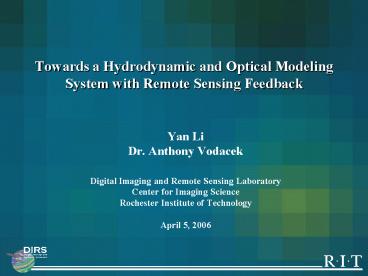Towards a Hydrodynamic and Optical Modeling System with Remote Sensing Feedback - PowerPoint PPT Presentation
1 / 22
Title:
Towards a Hydrodynamic and Optical Modeling System with Remote Sensing Feedback
Description:
state of the wind-blown air/water interface (wind speed) ... Meteorological data was from Buffalo weather station ... 0.0144 (where water absorbs minimally) ... – PowerPoint PPT presentation
Number of Views:25
Avg rating:3.0/5.0
Title: Towards a Hydrodynamic and Optical Modeling System with Remote Sensing Feedback
1
Towards a Hydrodynamic and Optical Modeling
System with Remote Sensing Feedback
- Yan Li
- Dr. Anthony Vodacek
- Digital Imaging and Remote Sensing Laboratory
- Center for Imaging Science
- Rochester Institute of Technology
- April 5, 2006
2
Outline
- Objective
- Methods
- Modeling (ALGE and Hydrolight 4.1)
- Remote sensing feedback
- Experimental Design Data
- Results
- Summary
3
Objective
- High resolution plume simulations at the mouth
of Niagara River and Genesee River to study the
transport and the 3D distribution of CDOM and
suspended sediments - Spectral remote-sensing reflectance at various
locations in the mouth of Genesee River was
calculated - Simulated remote-sensing reflectance compared to
remote imagery to provide a feedback mechanism to
the hydrodynamic model
4
ALGE
- 3D finite differencing hydrodynamic model
solving momentum, mass and energy conservation
equations - Realistic predictions of movement and
dissipation of plumes, sediments, and passive
tracers discharged into lakes - High resolution simulations for node-to-node
matching with satellite thermal imagery or
airborne imagery
Model output
Spatial data
Satellite image
- Geo-referenced site specific
- Bathymetry
- Weather data
- Inflow and outflow
5
Basic Hydrolight World
solar and atmospheric radiance
air/water interface
CHL TSS CDOM
bottom reflectance
6
Hydrolight
- Radiative transfer numerical model
- Input
- IOPs (absorption and scattering coefficients,
scattering phase function) - state of the wind-blown air/water interface
(wind speed) - sky spectral radiance distribution (built-in
model/MODTRAN) - nature of the bottom boundary
- AOPs (remote sensing reflectance Rrs)
Lw water leaving radiance Ed evaluated just
above the water surface
7
Physical Forcing Inputs
ALGE
3D Distribution of CDOM and TSS
Remote Imagery (Plume)
Algal Growth Model
Hydrolight 4.1
IOPs (a, b, bb)
Spectral Rrs or Radiance
Remote Imagery or Lab Analysis
8
Study Area Niagara River and Genesee River
Genesee River
Niagara River
9
Plume Simulation Forcing Factors
Horizontal resolution (m) Vertical resolution (m) Time Prevailing wind direction Average wind speed (m/s) Discharge flow rate (m3/s)
Niagara River Plume 325.0 3.0 June 6 15, 2004 west 6.1 7000.0
Genesee River Plume 135.0 3.0 June 6 15, 2004 west 4.7 2500.0
- Meteorological data was from Buffalo weather
station - Discharge flow rate was from US Army Corp. of
Eng. Detroit District - The high resolution, limited area simulations of
the plume were nudged from large scale whole lake
simulation - TSS modeled as particles and CDOM modeled as
passive tracers
10
a(760 nm) 2.55 (where water absorbs maximally)
a(430 nm) 0.0144 (where water absorbs
minimally) Absorption of red light is 177 times
stronger than absorption of blue light
Absorption coefficients Pope and Fry
(1997) Scattering coefficients Smith and Baker
(1981)
11
DIRS capabilities for field sampling and
in-water measurements (Dr. Tony Vodacek)
HydroRad-4 spectroradiometer HydroScat-2
backscatter meter
normalized to a(350)1.0 CDOM no scattering
12
Assuming chlorophyll scattering goes to zero soon
after 700 nm
Chlorophyll has maximal absorption coefficients
at 430 and 670 nm
13
Maximal absorption occurs at the lowest
wavelengths ( 350 nm) Absorption falls off
rapidly as wavelength increasing Absorption is
negligible beyond 500 nm
Specific absorption and scattering coefficients
are determined by Dr. Vodacek from the May 20,
1999 Lake Ontario water samples
14
Genesee River Plume
LANDSAT-7 visible image showing the Genesee River
plume on June, 14 2004 (spatial resolution 30 m)
15
MODIS calibrated and geo-located radiance (L1B)
image showing the Genesee River plume on June, 15
2004 (spatial resolution 250 m)
Genesee River Plume
Blue circle plume water Green circle lake water
16
visible
thermal
Modular Imaging Spectrometer Instrument (MISI)
Lake Ontario
plume
- Airborne line scanner
- 70 VNIR channels
- 5 thermal channels
- nominal 2 milliradian FOV (20ft GSD at 10,000ft)
- sharpening bands in VIS and LWIR
- LWIR thermal band detecting the upwelling track
caused by boat traffic - Plume traveling northward because of calm wind
conditions on June 7, 2004 - Westward track of the plume shown in MODIS image
due to prevailing wind from the east
17
Niagara River Plume shown by simulated surface
flow currents and passive tracer
Murthy, C.R., and K.C. Miners. 1989. Mixing
characteristics of the Niagara River plume in
Lake Ontario. Water Pollution Research Journal of
Canada 24(1)143-162.
18
Simulated Genesee River Plume
Suspended sediment concentration profile from
ALGE (g/m3)
plume water
19
CHL profile (Chl0 4.2, Zmax 100, h 7.5,
3.0)
CDOM absorption as an exponential function of
both wavelength and depth
Genesee River Plume
20
Water Quality Conditions
- Concentrations (Hydrolight variables)
- estimated from laboratory analysis on water
samples
CHL (mg/m3) TSS (g/m3) CDOM (absorption at 350 nm)
Lake Ontario 0.76 0.57 0.57
Genesee River Plume 4.28 10.00 2.75
21
Lake Ontario
Optical Identification of the Plume
compare Rrs
Genesee River Plume
The shaded bars at the bottom show the nominal
SeaWiFs sensor bands
22
Summary
- High resolution hydrodynamic simulations showing
the spread of plumes - Simulated vertical profile of suspended sediment
from ALGE - Spectral Rrs simulated from lab analysis showing
the optical identification of plume - Study of remote satellite/airborne imagery
(LANDSAT-7, MODIS, MISI)
Future work
- Modify ALGE to be spectral on shortwave range
(CDOM) - More optical property data for Niagara River
Plume - Retrieve more spectral information from remote
satellite/airborne imagery (LANDSAT-7, MODIS,
MISI)































